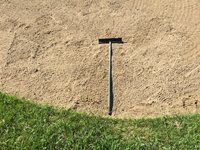I am often approached by members seeking advice as to how they can do their part in maintaining the golf course. At times it seems as though course managers can send mixed messages regarding course care and etiquette. For example, should we replace the divots taken in fairways or fill them with the provided sand mix? What about ball marks? Is there a right or wrong way to repair them? Is there an answer to the age old question about bunker rake placement? Following is a brief list of areas that we, as players, can assist in maintaining a course in pristine condition:
Ball Mark Repair:

The image above presents an accurate depiction of proper ball mark repair.
The most important thing to remember is to never “pop” the middle of the ball mark up. Research indicates that ball marks repaired in this way can take up to three weeks longer to heal. Think about the impact this can have on a short par 3 like #4!
Divot Repair:
The proper way to repair on a fairway depends upon the type of divot taken.
- Thick divots, those that still have soil attached, should be replaced and stepped down to encourage rooting.
- Thin divots, those that do not contain any soil or those that have been blasted apart, should be filled with our custom divot mix.The mix contains two types of seed, a special fertilizer blend, and organic material to help retain moisture.Please do not use the divot mix in the rough—it contains creeping bentgrass seed that is an undesirable species in the rough.
I am encouraged as I see many members beginning to use the proper divot pattern when on the practice areas. As was discussed in my last post, we encourage everyone to take their divots in strips, leaving one inch between strips. Taking divots in this manner will foster quicker recovery and more usable area on the practice areas. The two pictures below were taken on the practice tee.

This is a great example of the proper divot pattern. It makes better use
the teeing surface and will recover much more quickly.

This an example of the type of pattern we want to avoid. Even after
seeding it is unlikely this large area will recover by the end of the season.
Bunkers:
The most important aspect of bunker etiquette is for everyone to rake bunkers. With the exception of the putting greens, more labor is dedicated to maintaining the bunkers than any other area on the course. The picture on the right is an all too common occurrence—unraked footprints passing directly by a bunker rake.

The golf course staff at Hidden Glen has been trained to place the bunker rakes inside the bunkers, perpendicular to the edge. In addition to providing a consistent and polished look, this allows our mowers to more quickly move through the course as it is unnecessary for our operators to constantly move bunker rakes from their path. The attached photo demonstrates proper rake placement.
After meeting many of Hidden Glen’s members, it is evident that all take great pride in their golf course. By following and encouraging others to follow the techniques provided above, we can all do our part to help keep the course in the best shape possible. We thank you in advance for your continued support in these areas. As always, please feel free to contact me if you have any questions on these or any other items involving the course or proper course care.